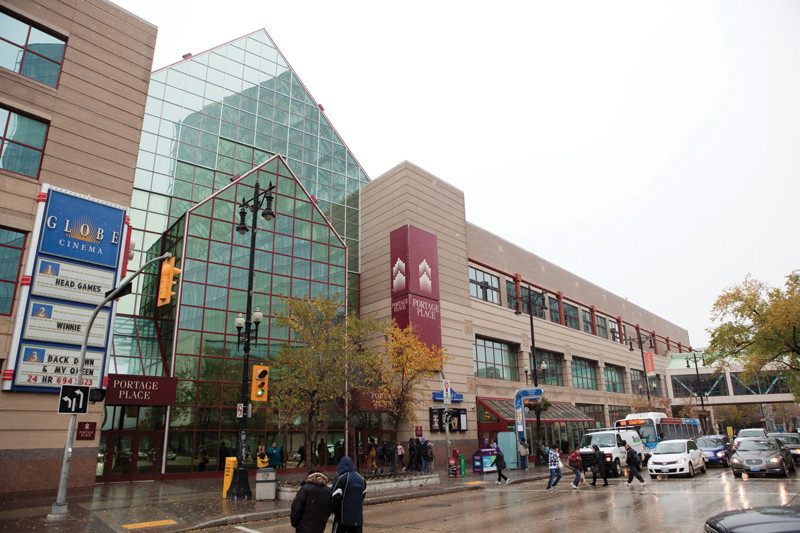Portage Place marks 25th anniversary
Design, financial concerns continue to beleaguer mall mega-project
On Sept. 17, 1987, Portage Place Shopping Centre - a $300 million retail, office and residential development meant to revitalize the north face of Portage Avenue - opened to thousands of frenzied customers in downtown Winnipeg.
On Sept. 17, 2012, Portage Place marked its 25th anniversary with a modest gathering of retailers and community members over a piece of cake.
This transition - from a revolutionary downtown development project to a tired community mall - has spurred conversation about the importance of this landmark anniversary.
“The goal of Portage Place was obviously to revitalize the neighbourhood; it didn’t do that,” said Kevin McDougald, urban affairs blogger from The View from Seven blog.
Portage Place Shopping Centre was the brainchild of former mayor Bill Norrie, the Forks North Portage Partnership and several other private actors, including investment firm Cadillac Fairview Corporation Limited, the original private operators of the site who contributed $12 million to its development.
In 1987, in the face of desolation along the north side of Portage Avenue and rampant crime, these actors decided to demolish a five block section of the street, which included 32 stand-alone buildings, to make way for what was then considered a dynamic, mixed-use structure.
According to a CBC report at the time of its opening, the project was intended to bring a slice of suburban life to the heart of Winnipeg’s downtown, with Portage Place linked with the Bay and Eaton’s retail stores through skywalks.
The shopping centre was also intended to connect residential development along Ellice Avenue with office buildings along Portage Avenue. It’s original design included both private and public uses, with areas like the skywalks and the Edmonton Court promenade meant for more than just shopping and eating.
However, criminal activity early in the mall’s history - along with the rerouting of foot traffic away from the street - contributed to a failed revitalization project, according to McDougald.
“A big part of the problem is that it took a lot of pedestrian traffic off the streets instead of making the streets more lively, which should have been the whole goal of urban redevelopment,” he said. “It left the rest of the neighbourhood looking kind of desolate and abandoned.”
According to the Winnipeg Sun, Portage Place has been re-sold at least four times since 1987, including in 1997 for $43 million and in 2005 for just $15 million.
In 2062, the mall will become the property of Forks North Portage Partnership in the absence of a private developer interested in maintaining it, according to a 1987 CBC report.
For Brian Kelcey, a former adviser to current mayor Sam Katz and a city politics instructor at the University of Winnipeg, Portage Place is symptomatic of a larger cultural problem in Winnipeg.
“ We in Winnipeg still have not broken free from Portage Place syndrome - ... this idea that one big, public project can transform a neighbourhood.
Brian Kelcey, city politics instructor, University of Winnipeg
“The reason the anniversary is a useful moment of reflection is because we in Winnipeg still have not broken free from Portage Place syndrome - ... this idea that one big, public project can transform a neighbourhood,” he said, adding that while public projects can help, cities are more complex than civic leaders sometimes make them out to be.
“Civic thinkers and leaders of the time in Winnipeg and many other cities thought that the way to fix downtown was to compete with the suburbs on the suburb’s terms.”
Retail problems
In addition to financial reports worrying whether Portage Place can repay its loans, the mall has also faced criticism for failing to attract quality retail options for downtown residents and shoppers.
In 2010, The Uniter reported that three large retail stores - Carlton Cards, Smart Set and Barnes & Castle - had vacated the mall at a time when Portage Place’s retail leases were incredibly low compared to its primary competition.
A year earlier, MJB Consulting, a New York-based firm, had released a report on downtown Winnipeg recommending Portage Place move toward “cheap chic” and “cross-over” options that appeal to lower income downtown residents and students looking for a bargain.
Dave Stone, mall manager at Portage Place, said the recommendations of the MJB report have yet to be implemented and that the shopping centre offers more to the community than just retail.
“I don’t know if you could measure success from that report specifically at this point in time, but it played a large role in how we move forward over the next few years in how we develop our downtown in general,” he said.
Stone argues Portage Place is a community shopping centre that offers a mix of uses to residents and downtown office workers alike.
“It serves a big role to those who live in the downtown for a number of years and it certainly will serve that purpose in my mind. ... I think the role it has played and will continue to play is to be that kind of community shopping centre.”
For more on crime and safety at Portage Place Shopping Centre, including an interview with a former Winnipeg police officer, visit Ethan Cabel’s blog at www.uniter.ca/blog.
Published in Volume 67, Number 6 of The Uniter (October 11, 2012)







